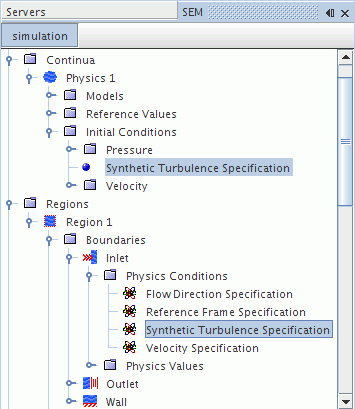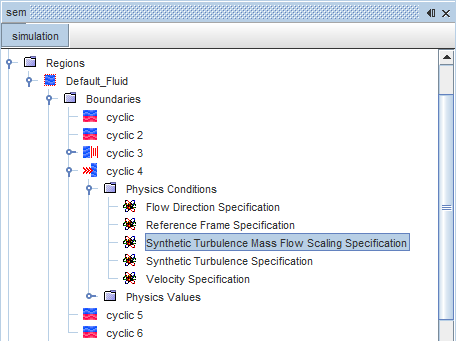Setting Up Synthetic Eddy Method
The Synthetic Eddy Method is activated when any of the LES or DES turbulence models are selected.
You can access its settings through the Synthetic Turbulence Specification node which is located under both the Initial Conditions node of a physics continuum and Physics Conditions node of an inflow boundary.

To activate SEM:
- Specify either Intensity + Length Scale or Reynolds Stress + Length Scale in the
Method property of the
Properties window.

- Provide either a value or distribution for the turbulence intensity or the six components of the (symmetric) Reynolds stress tensor.
The values for turbulence intensity or the Reynolds stress tensor may come from experimental data, from precursor RANS or LES simulations, or from some other approximation. If running a precursor simulation, Reynolds stress data can only be obtained by running an LES simulation, or a RANS simulation using a Reynolds Stress Transport turbulence model. For other turbulence models, the isotropic turbulent intensity can be computed from the turbulent kinetic energy.
In many cases, a constant length scale, representative of eddy size, is sufficient for the Turbulent Length Scale. When using a RANS precursor simulation, the integral length scale can be calculated and used. For wall bounded flows, the wall distance may be a suitable approximation of the length scale when this information is not available from elsewhere. If the given length scale is inappropriate for the flow, the resolved turbulence may take much longer to develop, or disappear altogether.
When computing the SEM velocities, the number of eddies that are used in the calculation is inversely proportional to the cube of the length scale. To prevent the number of eddies becoming too large and affecting run-time and memory requirements, it is good practice to limit the minimum value of the length scale.
Synthetic Turbulence Mass Flow Scaling
If you use the Synthetic Eddy Method at inflow boundaries, there is no guarantee of constant mass flow. This can cause problems for the solver, especially for incompressible cases. In such cases, use the Synthetic Turbulence Mass Flow Scaling Specification to add a correction that maintains constant mass flow by scaling the computed fluctuations.
This specification is available whenever the Synthetic Turbulence Specification is available.
